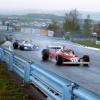Old Chorley Road, The Home of Chevron Racing Cars - Circa 1966
The legacy of the Chevron Marque is one of speed, beauty and success. The founder and creator of these cars, what many consider to be some of the most beautiful of the sports racers, was Derek Bennett. Born in Manchester in 1933, he fought poor health as a child, suffering from asthma and dermatitis and contracting pneumonia. In those circumstances he had little chance to shine academically and he went automatically to the Secondary Modern school close to his home.
After leaving at 15 he took up an apprenticeship as an electrical engineer, but he left his job as soon as he was 21 to turn his passionate interest in building and repairing cars into a full-time occupation. Working for himself in a tiny lock-up in Salford he soon got his first taste of racing on the shale speedway track at Manchester’s Belle Vue, first with a stock car, and then in an open-wheeled Midget racer – the first racing car he built himself. Success hadn’t come easily for Bennett though. When he worked all night at Gerry Kinnane’s garage off Belfast’s Falls Road to get his Clubmans car ready for its first race at Kirkistown he was just completing another shoestring project in a line stretching back ten years.
The recent growth in the popularity of historic racing has brought a resurgence of interest in Chevrons through Derek Bennett’s early sport scars, particularly the ubiquitous B8, and the B16 coupé. Bennett’s designs covered virtually all categories of national and international racing during the late ’60s and the ’70s, and won in Formula 3, Formula Atlantic, Formula 5000 and Formula 2 as well as sports car racing. No fewer than six future Formula 1 World Champions were among those who raced Chevrons at important stages in their careers.
I bring this up as I've just been catapulted into the ownership ranks of a B16 coupe. ol' Harry just wouldn't let go of a prospective buyer... I saw this car when I was in CO a couple of weeks ago... We talked about it and discussed it's fine condition and the all important price point that was within budget... I loved the shape, but I was really looking for a bit more grunt. When he called and told me that this car would be perfect as an entry level historic racer for me and mentioned that it really wasn't a sloth with 300 hp moving 1,500 lbs. And when he mentioned that it's performance characteristics are similar to my old CSR, I rethought the situation. It was a perfectly refurbished car and all important structural elements have been gone through and either replaced or checked. All logs were in order and its history was thoroughly documented. There is some refitting of the pedals that had to be done to accommodate my length, but once inside, I feel very comfortable in the closed cockpit. I've signed up with The Chevron Association and the next stop, WSIR in late July to give it and me a proper shakedown drive. Then into the fray! But enough about that for now...
More to the story
At the time of Derek Bennett’s death, Chevron was an established volume racing car manufacturer, competing on a level with the likes of March, Lola and Ralt throughout the world. But many of Derek’s cars’ most memorable victories came in the earlier years as Chevrons fought against the odds, David and Goliath fashion. They tended to involve two drivers, Brian Redman and Peter Gethin, whose successes passed into Chevron legend.
The ability of so many of Derek Bennett’s cars to win from new was all down to the extraordinary way in which the cars were built, and the potent combination of Derek’s skills as driver and engineer. With no technical qualifications, he had no need for a drawing board. Sometimes he would commit an idea to the back of a paper serviette in a café, but generally he carried everything in his head. Left in a corner with a pile of steel tube and a welding torch he would set to work making a racing car.
Designing it and building it were one and the same process, and when the prototype was finished, Derek became the test driver, hurling the new car round Aintree, Oulton Park or Croft until he had it set up to his liking, occasionally dashing back to the factory to make a small modification, and then returning to finish the job.
When the prototype was ready to race Derek would hand it over to his men at the factory so that they could dismantle it again for the draughtsmen to draw. Only then could the jigs be built and the parts ordered to put the new model into production.
The advent of monocoque construction forced Derek to alter his design methods somewhat, but he continued to build and test all his own prototypes. His success as a designer had forced him to give up his aspirations as a racing driver, but he retained his ability on the track and was as quick as all but the very best in testing, even at the wheel of a Formula 2 or F5000 car.
Derek was killed just as motor racing was about to move into the era of the wing car and the question of how he would have responded to this fundamental change in design is a tantalizing one. He lamented the passing of the space frame, which was so well suited to his intuitive design methods, but at the same time he had a fascination with aerodynamics, kindled in his teenage years when he was a keen aeromodeller, and revived by his discovery of hangliding. Tragic was his end, a result of another pursuit of passion.
I'm sure there are some here who could elaborate on the actual drivers and events where the Chevrons battled and won over greater cars. I understand that there was quite a history of competition between Lola and Chevron at one point.





































